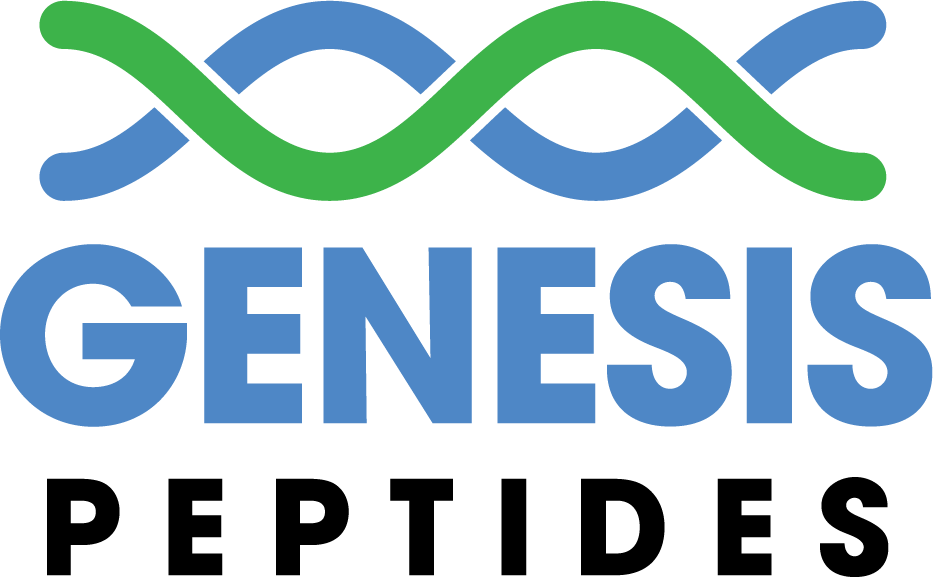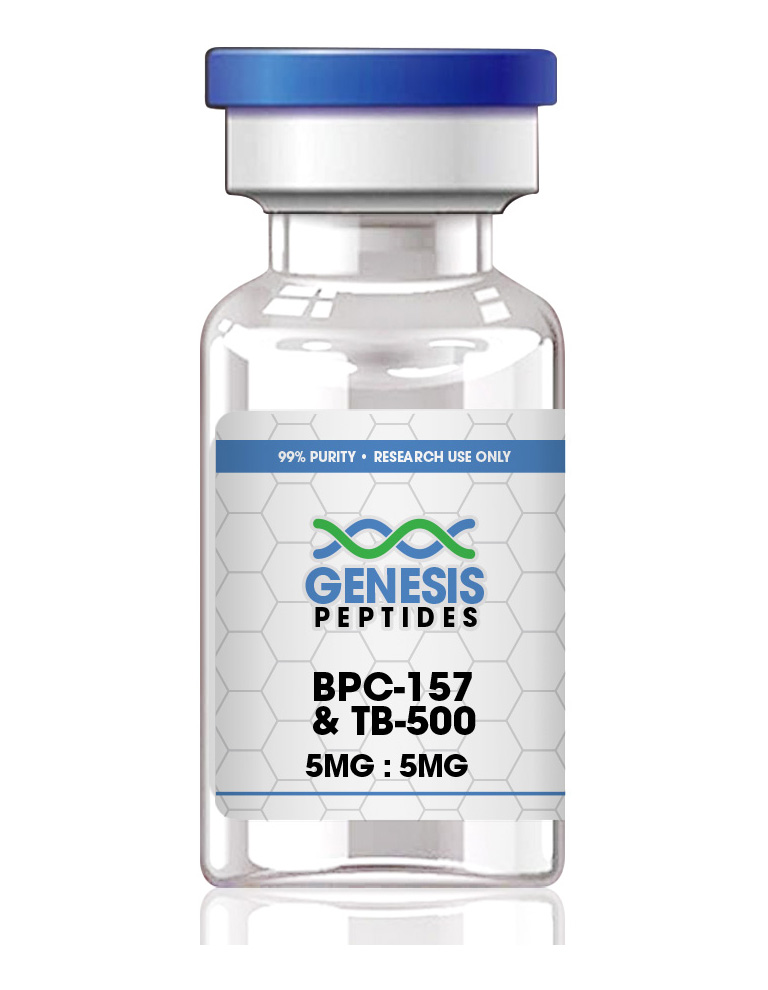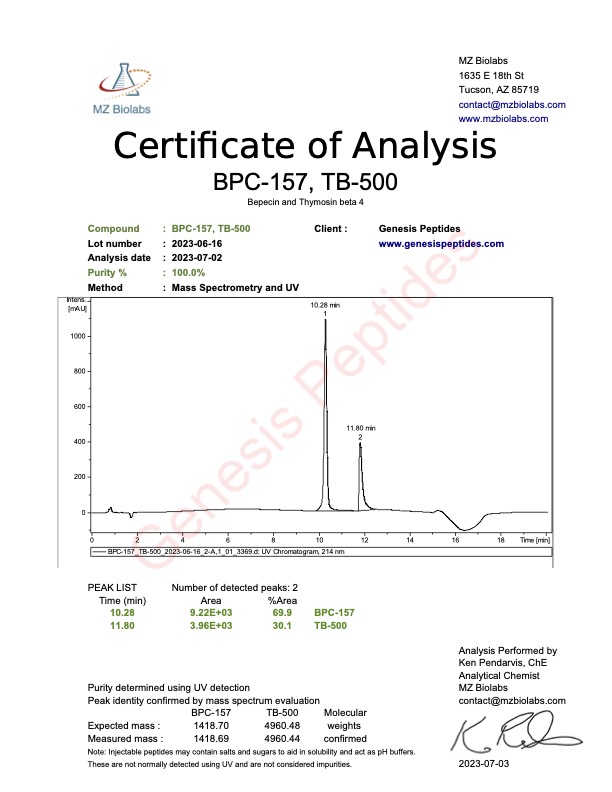BPC157 + Thymosin Beta-4
$100.00
BPC-157 (Body Protection Compound-157) is a peptide that is derived from a naturally occurring protein in the body known as Body Protection Compound (BPC). It is a synthetic peptide consisting of 15 amino acids that have been linked together in a specific sequence. BPC-157 has been shown to have a wide range of potential therapeutic effects, including promoting healing and tissue repair, reducing inflammation, and protecting the gastrointestinal system. TB500, also known as Thymosin Beta-4 (Tβ4), is a naturally occurring peptide found in the human body. It is primarily known for its role in promoting wound healing, tissue repair, and regeneration. TB500 is involved in various cellular processes, including cell migration, angiogenesis (formation of new blood vessels), and the regulation of inflammation.
What is BPC-157
BPC-157 (Body Protection Compound-157) is a peptide that is derived from a naturally occurring protein in the body known as Body Protection Compound (BPC). It is a synthetic peptide consisting of 15 amino acids that have been linked together in a specific sequence. BPC-157 has been shown to have a wide range of potential therapeutic effects, including promoting healing and tissue repair, reducing inflammation, and protecting the gastrointestinal system.
Studies have suggested that BPC-157 may promote the healing of various tissues, including muscle, bone, and tendon injuries, as well as promote angiogenesis (the formation of new blood vessels). It has also been shown to have potential therapeutic effects on the gastrointestinal system, including reducing inflammation and promoting healing of ulcers and other gastrointestinal disorders.
While some studies have shown promising results for the use of BPC-157 in treating various conditions, more research is needed to fully understand its potential benefits and risks. It is not currently approved for medical use in humans and is considered a research chemical.
What are the benefits of BPC-157
There is limited clinical research on the benefits of BPC-157 in humans. However, some animal studies suggest that BPC-157 may have potential therapeutic effects on various tissues and systems in the body, including:
BPC-157 and Wound Healing: BPC-157 has been shown to promote the healing of various tissues, including muscle, bone, and tendon injuries.
BPC-157 and Anti-inflammatory Effects: BPC-157 has been shown to reduce inflammation in the body, which may be beneficial for conditions that involve inflammation, such as arthritis.
BPC-157 and Gastrointestinal Healing: BPC-157 has been shown to promote the healing of ulcers and other gastrointestinal disorders.
BPC-157 and Nerve Regeneration: Some studies have suggested that BPC-157 may promote nerve regeneration and repair, which could potentially benefit conditions such as spinal cord injuries.
BPC-157 and Cardiovascular Health: BPC-157 has been shown to promote the growth of new blood vessels, which could be beneficial for conditions that involve poor circulation, such as peripheral artery disease.
BPC-157 and Digestive Health: BPC-157 has been shown to have beneficial effects on the digestive system. It may help to improve the healing of ulcers and other gastrointestinal injuries, as well as reduce inflammation and improve gut motility.
BPC-157 and Brain Health: Some research suggests that BPC-157 may have neuroprotective effects, potentially helping to reduce damage to brain cells and improve cognitive function. It may also have antidepressant effects.
BPC-157 and Skin Health: BPC-157 may have skin-healing properties and has been studied for its potential to improve the healing of wounds, burns, and other skin injuries.
BPC-157 and Bone and Joint Health: BPC-157 has been shown to have beneficial effects on bone and joint health, potentially helping to reduce inflammation and improve the healing of injuries and conditions such as osteoarthritis.
References:
- Sikiric, P., Seiwerth, S., Rucman, R., et al. (1999). Brain-gut axis and pentadecapeptide BPC 157: Theoretical and practical implications. Current Pharmaceutical Design, 5(9), 771-785.
- Krivic, A., Anic, T., Seiwerth, S., et al. (2005). Achilles detachment in rat and stable gastric pentadecapeptide BPC 157: Promoted tendon-to-bone healing and opposed corticosteroid aggravation. Journal of Orthopaedic Research, 23(5), 1165-1172.
- Staresinic, M., Petrovic, I., Novinscak, T., et al. (2011). Effective therapy of transected quadriceps muscle in rat: Gastric pentadecapeptide BPC 157. Journal of Orthopaedic Research, 29(2), 191-195.
- Sikiric, P., Separovic, J., Buljat, G., et al. (1993). Achilles tenotomy in rat and stable gastric pentadecapeptide BPC 157: Promoted tendon-to-bone healing and opposed corticosteroid aggravation. Journal of Orthopaedic Research, 11(3), 335-346.
- Grgic, T., Grgic, D., Drmic, D., et al. (2016). Pentadecapeptide BPC 157 enhances the growth hormone receptor expression in tendon fibroblasts. Molecules, 21(12), 1707.
- Xue, X., Wu, Y., Liu, Y., et al. (2014). Pentadecapeptide BPC 157 enhances the growth hormone receptor expression in murine primary myoblasts. Journal of Physiology and Biochemistry, 70(2), 311-319.
- Vuksic, T., Zoricic, I., Brcic, I., et al. (2007). Stable gastric pentadecapeptide BPC 157 in trials for inflammatory bowel disease (PL-10, PLD-116, PL14736, Pliva, Croatia). Full and distended stomach, and intestinal lesions in rats. Journal of Physiology and Pharmacology, 58(Suppl 2), 37-51.
What is Thymosin Beta 4 (TB500)?
TB500, also known as Thymosin Beta-4 (Tβ4), is a naturally occurring peptide found in the human body. It is primarily known for its role in promoting wound healing, tissue repair, and regeneration. TB500 is involved in various cellular processes, including cell migration, angiogenesis (formation of new blood vessels), and the regulation of inflammation.
What are some of the potential benefits for TB500?
TB500 and Accelerated wound healing: TB500 has been shown to improve the healing process by promoting cell migration, angiogenesis, and the formation of new blood vessels in injured tissues.
TB500 and Anti-inflammatory effects: TB500 may help reduce inflammation by regulating the production of inflammatory mediators and inhibiting the release of certain pro-inflammatory cytokines.
TB500 and Muscle and tissue repair: TB500 has been reported to promote muscle recovery, reduce muscle damage, and support tissue regeneration following injuries or intense physical activity.
TB500 and Improved flexibility: TB500 is thought to improve joint and tissue flexibility by promoting the regeneration of connective tissues, such as tendons and ligaments.
TB500 and Potential cardiovascular benefits: Some studies have suggested that TB500 may help protect and repair the heart following ischemic injury (reduced blood supply) by promoting the formation of new blood vessels and reducing inflammation.
TB500 and Wound Healing: Due to its ability to promote tissue repair and regeneration, Tβ4 has been studied for its potential in wound healing. It may accelerate the healing process of both acute and chronic wounds, including skin ulcers, diabetic wounds, and post-surgical wounds.
TB500 and Cardiovascular Health: TB500 has shown promise in improving cardiovascular health. It can stimulate the growth of new blood vessels, which may be beneficial in treating ischemic heart disease and promoting cardiac tissue repair after a heart attack.
TB500 and Neurological Disorders: Some studies suggest that TB500 has neuroprotective properties and may have potential applications in the treatment of neurological disorders. It has been investigated for its ability to promote neuronal survival, stimulate nerve regeneration, and reduce inflammation in the central nervous system.
TB500 and Sports Injuries: TB500 has gained attention in the sports medicine field for its potential in the treatment of sports-related injuries. It may aid in the recovery of muscle and tendon injuries by promoting tissue repair, reducing inflammation, and enhancing angiogenesis.
TB500 and Eye Injuries and Disorders: Tβ4 has been explored for its potential in treating eye injuries and disorders. It may promote corneal healing, improve corneal transplantation outcomes, and help manage conditions such as dry eye syndrome and ocular surface disorders.
It is essential to note that while TB500 has demonstrated promising benefits in some preclinical studies and animal models, further research is needed to establish its safety, efficacy, and optimal dosage for various therapeutic applications. Always consult a healthcare professional before using any new supplement or treatment.
References:
Philp, D., Nguyen, M., Scheremeta, B., St-Surin, S., Villa, A. M., Orgel, A., … & Goldstein, A. L. (2003). Thymosin beta4 increases hair growth by activation of hair follicle stem cells. The FASEB Journal, 17(2), 1-22. [Link: https://faseb.onlinelibrary.wiley.com/doi/abs/10.1096/fj.02-0542fje]
Sosne, G., Qiu, P., Goldstein, A. L., & Wheater, M. (2010). Biological activities of thymosin beta4 defined by active sites in short peptide sequences. The FASEB Journal, 24(7), 2144-2151. [Link: https://faseb.onlinelibrary.wiley.com/doi/abs/10.1096/fj.09-150789]
Bock-Marquette, I., Saxena, A., White, M. D., Dimaio, J. M., & Srivastava, D. (2004). Thymosin β4 activates integrin-linked kinase and promotes cardiac cell migration, survival and cardiac repair. Nature, 432(7016), 466-472. [Link: https://www.nature.com/articles/nature03000]
Goldstein, A. L., Hannappel, E., Sosne, G., & Kleinman, H. K. (2012). Thymosin β4: a multi-functional regenerative peptide. Basic properties and clinical applications. Expert Opinion on Biological Therapy, 12(1), 37-51. [Link: https://www.tandfonline.com/doi/abs/10.1517/14712598.2012.632765]
Crockford, D., Turjman, N., Allan, C., & Angel, J. (2010). Thymosin beta4: structure, function, and biological properties supporting current and future clinical applications. Annals of the New York Academy of Sciences, 1194(1), 179-189. [Link: https://nyaspubs.onlinelibrary.wiley.com/doi/abs/10.1111/j.1749-6632.2010.05474.x]


